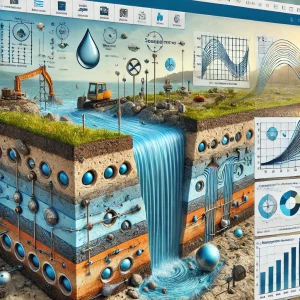Seepage is a fundamental concept in geotechnical engineering, directly influencing the stability and safety of critical structures such as slopes, foundations, and earth-retaining walls. Properly managing and understanding seepage is essential to ensuring long-term structural integrity, especially in projects involving soil and rock.
In this post, we’ll explore the theory behind seepage, how it impacts slope stability, and how GEO5 Software offers advanced tools for modeling seepage using the Finite Element Method (FEM). This knowledge is vital for geotechnical engineers looking to enhance their expertise and make more informed decisions in their projects.
What is Seepage?
Seepage refers to the movement of water through the pores of a soil or rock medium due to a hydraulic head difference (i.e., the difference in water pressure between two points). Seepage can either be steady (where the water flow rate remains constant over time) or transient (where it fluctuates over time).
In geotechnical engineering, managing seepage is critical because it influences:
- Pore water pressure: As water seeps through the soil, it generates pore pressure, reducing the effective stress that helps maintain the soil’s shear strength. If pore water pressure becomes too high, it can result in slope instability or even failure.
- Flow patterns: Seepage can originate from various sources such as rainfall, rising water tables, or nearby bodies of water. The direction and rate of water flow significantly impact pore pressure development, particularly in slopes. Even minor seepage changes can have substantial effects on stability.
- Seepage forces: These forces arise from the water moving through the soil, potentially destabilizing the slope by causing upward pressure or washing away fine particles through piping, leading to voids and eventual failure.
Seepage’s Role in Slope Stability
Seepage is especially important in slope stability analysis, where the interaction between soil, water, and structural forces must be carefully evaluated. Slope failures often occur when water infiltrates the soil and raises pore water pressure, thereby reducing the soil’s effective stress and shear strength.
- Pore Water Pressure: When seepage increases pore water pressure beyond critical levels, the internal stability of the slope is compromised, increasing the risk of landslides or slope failure. Monitoring and managing this pressure is key to slope safety.
- Horizontal and Vertical Seepage: Seepage patterns influence how water affects slope stability. For example, vertical seepage tends to induce higher pore pressures than horizontal seepage in certain soils, making a detailed seepage analysis essential for designing stable slopes.
- Seepage Forces: These forces can displace soil particles, particularly in fine-grained soils like silt or sand. Over time, this displacement weakens the structure, potentially leading to collapse.
Seepage Analysis in GEO5 Software
GEO5 provides geotechnical engineers with advanced tools for modeling seepage using the Finite Element Method (FEM) in its Water Flow module. This software allows users to simulate water flow through soil masses, calculate pore pressures, and assess the impact on slope stability. The module supports both steady-state and transient seepage conditions.
- Steady-State Seepage: This type of analysis assumes a constant water flow over time, making it ideal for evaluating long-term conditions such as stabilized groundwater levels after seasonal changes or rainfall.
- Transient Seepage: For scenarios where water levels or flows fluctuate over time (e.g., during or after a storm), transient seepage analysis accounts for these time-dependent changes in pore pressure and saturation, providing a more realistic assessment of slope stability.
- Permeability and Saturation: GEO5 allows users to input soil permeability values and define boundary conditions such as water levels or impermeable layers. For unsaturated soils, the software also uses advanced models like Van Genuchten, which simulates how suction and capillary action affect water movement above the water table.
Key Parameters for Seepage Analysis
To conduct an accurate seepage analysis, geotechnical engineers need to define several important parameters:
- Hydraulic Conductivity (Permeability, KK): This defines how easily water can flow through the soil. Coarse-grained soils like sand have high permeability, while fine-grained soils like clay resist water movement, influencing the rate of seepage.
- Saturation Degree: In unsaturated soils, the spaces between particles are only partially filled with water. Understanding the degree of saturation is critical for determining how water flows through these soils, particularly above the water table.
- Boundary Conditions: Engineers must define where water enters and exits the system, whether from natural sources (e.g., rivers or rainfall) or engineered structures (e.g., drainage systems or impermeable layers).
Recommendations for Using Seepage Analysis in Slope Stability Projects
- Assess Steady-State vs. Transient Conditions: For long-term stability, focus on steady-state seepage. However, for more dynamic environments where water levels fluctuate, always consider transient seepage to account for real-world changes.
- Combine Seepage with Limit Equilibrium Methods: Using GEO5, seepage analysis results can be integrated with Limit Equilibrium Methods (LEM) for slope stability assessments, ensuring that water pressures are accounted for in safety factor calculations.
- Calibrate Models with Field Data: Where possible, calibrate your seepage models with real-world data from field tests or site investigations to improve accuracy.
- Monitor Seasonal and Climatic Variations: In areas prone to heavy rainfall or seasonal water level changes, perform transient seepage analyses to predict how these fluctuations might affect slope stability over time.
Conclusion
Seepage analysis is an essential component of geotechnical engineering, particularly in slope stability assessments. By understanding the movement of water through soil and how it affects pore pressure, engineers can better predict and mitigate potential slope failures. With GEO5’s FEM Water Flow module, professionals can simulate both steady-state and transient seepage conditions, ensuring more accurate and reliable stability predictions.
For geotechnical engineers seeking to deepen their understanding of seepage and its role in slope stability, tools like GEO5 provide the flexibility and precision needed to tackle complex projects. Explore the software and stay ahead of the curve in your geotechnical assessments.


